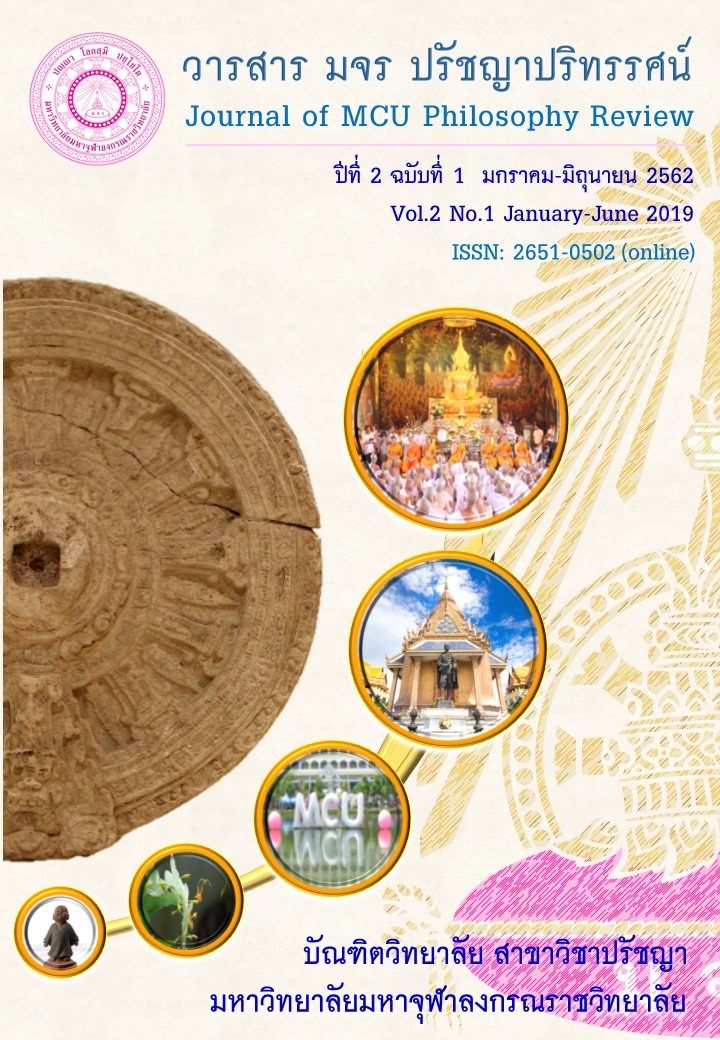The Effect of Meditation toward Brain Functions, Immune System or DNA
Main Article Content
Abstract
This article entitled to study the concept of the Meditation in Buddhist canons, to analyze the Meditation toward Brain Functions, Immune System or DNA. This is a qualitative research done by studying academic documents. In the research, it was found that Brahma Vihara in the Sutra is prayed for all beings to bring peace to the giver and the receiver. In addition, the practice of compassion in the Brahmānāsāna in the Visuttimakka is still able to see most of the similarities. Some of the procedures are different, but it can be considered in the same direction. From the research, it can be seen that the practice can increase the prefrontal cortex, amygdala, and insula in the brain. Gamma brainwaves found higher while experts were practicing meditation. This gamma brainwave is related to the intelligence of each person. The effects of the practice on the immune system, it was found that after the 8 weeks of training period, the vaccination against influenza showed significantly higher antibodies than the control group. In addition, when studying the effects of compassion at the cellular and DNA levels, the results show that it is astounding that the operator has longer Telomere DNA in the control group and has more Telomerase enzymes in the control group. This is an important factor that makes the body and skin of the meditation practitioners always look bright and young.
Article Details
บทความที่ได้รับการตีพิมพ์เป็นลิขสิทธิ์ของวารสาร มจร ปรัชญาปริทรรศน์
ข้อความในบทความที่ได้รับการตีพิมพ์ในวารสาร ถือเป็นความรับผิดชอบของผู้เขียนบทความ และข้อคิดเห็นนั้นไม่ถือว่าเป็นทัศนะและความรับผิดชอบของกองบรรณาธิการวารสาร มจร ปรัชญาปริทรรศน์
References
พระพรหมคุณาภรณ์ ( ป.อ. ปยตฺโต ). (2553). พจนานุกรมพุทธศาสตร์ ฉบับประมวลธรรม. พิมพ์ครั้งที่ 19. นนทบุรี: บริษัท เอส.อาร์. พรินติ้ง แมส โปรดักส์ จำกัด.
พระพุทธโฆสเถระ. (2553) วิสุทธิมรรค ภาค 2 ตอน 1. แปลโดยมหามกุฎราชวิทยาลัย. พิมพ์ครั้งที่ 12. กรุงเทพมหานคร: โรงพิมพ์มหามกุฎราชวิทยาลัย.
มูลนิธิมหามกุฎราชวิทยาลัย. (2556). มิลินทปัญหา ฉบับแปลในมหามกุฎราชวิทยาลัย,พิมพ์ครั้ง 5. กรุงเทพมหานคร: มหามกุฎราชวิทยาลัย.
อาจอง ชุมสาย ณ อยุทธยา. (2555). แนวทางสู่ความสุข . พิมพ์ครั้งที่ 11 . กรุงเทพมหานคร: เอ.พี. กราฟิค ดีไซน์ และการพิมพ์ จำกัด.
Masaru Emoto. (2555). มหัศจรรย์แห่งน้ำ. แปลโดยดาดา. พิมพ์ครั้งที่ 4. กรุงเทพมหานคร: บริษัทแปลนพริ้นติ้ง.
อรวรรณ ศีลปกิจ (2557). “พุทธวิธีการสอนให้เกิดการตระหนักรู้”. สารนิพนธ์พุทธศาสตรดุษฎีบัณฑิต. บัณฑิตวิทยาลัย, มหาวิทยาลัยมหาจุฬาลงกรณราชวิทยาลัย.
Devidson, R et al. (2003). “Alterration in Brain and Immune Function Produced by Mindfulness Meditation”. Psychosomatic Medicine. 65 (2003).
Gyorgy Buzsaki. (2006). Rhythm of the Brain. New York: Oxford University press.
The Society for Neuroscience. (2002). Brain Fact. Fourth edition. China: Everbest Printing Company.
Alda M et al. (2016). “Zen meditation, Length of Telomeres, and the Rols of Experiential Avoidance and Compassion”. Springer. [online]. สืบค้นจาก: DOI 10.1007/ s12671-016-0500-5 http://www.Springerlink.com [Feb. 21,2016]
Blackburn E. (2009). “Telomeres and Telomerase: The Means to the End”. Nobel Lecture. สืบต้นจาก: http://www.nobelprize.org [December 72009].
Devidson R. et al. (2008). “Buddha’s Brain: Neuroplasticity and Meditation”. Signal Process Mag. สืบค้นจาก: http://www.nebi.nih.gov/pmc/articles/PMC2944261/ [Jan.1,2008].
Devidson R. et al. (2004). “Well-Being and Affective Style: Neural Substrates and Biobehavioural correlates”. The Royal Societies. . สืบค้นจาก: http//www. The royalsociety/doi:10.1098/rstb.2004.1510 [August, 2004]
Jacobs TL. et al. (2010). “Intensive Meditation Training, Immune Cell Telomerase Activity, and Psychological Mediators”. Psychoneuroendocrinology . สืบค้นจาก : http://www.elsevier.com/locate/psyneuen [2010].
Lutz, A et al. (2004). “Long-Term Meditators Self-Induce High-Amplitude Gamma Synchrony During Mental Practice”. PNAS. Vol.101 No.46. สืบค้นจาก: http://www.pnas.org [November,2004].
Lutz A. et al. (2008). “Regulation of the Neural Circuitry of Emotion by Compassion Meditation: Effect of Meditative Expertise”. PLoS One.3 (3) e1897. สืบค้นจาก: www.plosone.org [March 2008].


